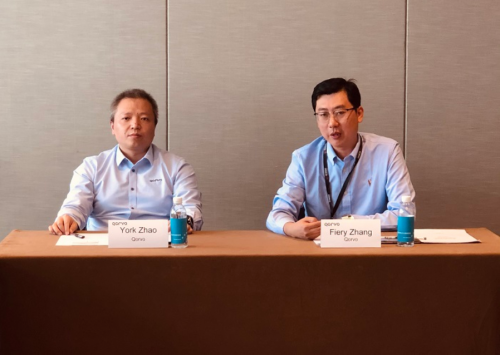In the 5G era, terminals have become the focus of attention in various industries. The terminal is the part closest to the user and directly affects the user’s 5G experience. In smart terminals, the RF front-end module takes the lead, and the technological innovation of the RF front-end module promotes the development of mobile communication technology. In the trend of the 5G era, RF front-end modules are also undergoing a new round of technological innovation.

As one of the heavyweight players in the RF front-end module field, Qorvo has carried out a comprehensive technical update on the RF front-end module. In order to understand Qorvo’s innovations in PAMiD and self-shielding technology, all media reporters from Communications World interviewed York Zhao, deputy director of Qorvo Packaging New Product Engineering Department, and Fiery Zhang, Qorvo North China Application Engineering Manager. 5G ushered in a new round of changes in the semiconductor industry The advent of the 5G era has brought new growth opportunities for smartphones. According to the latest report released by Strategy Analytics, global demand for 5G mobile phones rose sharply in the first quarter of this year. Its shipments in the first quarter exceeded last year’s 18.7 million units. 24.1 million units. The huge increase in the 5G mobile phone market has created opportunities for the development of RF front-ends. It is understood that the wireless communication module includes four parts: antenna, RF front-end module, RF transceiver module and baseband signal processor. Among them, the RF front-end and antenna are areas where both volume and price are rising, and the demand is rapidly expanding. At the same time, in the 5G era, the number of signal frequency bands has increased significantly, and the number of required components has also increased significantly. At the same time, 5G communication equipment needs to be backward compatible with 4G and 3G, so the incremental market is considerable. But opportunities are accompanied by challenges. The development of 5G smart phones has brought a new round of technological changes to the semiconductor industry. In the 5G era, the frequency bands that mobile devices can use gradually increase, which also means that more radio frequency components need to be added. The increase in the number of RF front-end devices has led to tight PCB space in mobile phones and increased process difficulty, which has also led to an exponential increase in the complexity of the RF front-end. Regarding the challenges encountered in RF front-end design, Zhang Jie said: “5G RF front-end design is much more difficult than 4G. First, 5G mobile phones must be backward compatible with 2G, 3G, and 4G, and need to support increased frequency bands; second, 5G equipment There are more integrated devices, which puts forward new requirements on product size; third, 5G mobile phones have greatly improved linearity, EVM and other performance requirements. Therefore, the design difficulty of 5G RF front-end is greatly increased.” LNA integration into PAMiD has become a trend In order to solve the many challenges encountered by the RF front-end in the 5G era, RF companies have carried out in-depth research. With the maturity of RF front-end module technology and market demand, since 2016, the main RF front-ends in the market have begun to develop in a modular direction, and several major modules such as duplexers and antenna switches have begun to be integrated into the RF front-end. During the period, RF front-end modules have also developed several categories, including ASM, FEMID, PAMiD, etc. Among them, PAMiD has the highest degree of modularity, which mainly integrates multi-mode and multi-frequency PA, RF switches, filters and other components. For mobile phone manufacturers, the emergence of PAMiD makes the RF front-end simpler from a complicated system design project. With the advent of the 5G era, PAMiD required for mobile phones is also continuing to be integrated. As a leader in the global RF field, Qorvo utilizes highly integrated IF/HF module solutions to provide a wide range of new product launch support for many smartphone manufacturers. “Qorvo is committed to developing an integrated PAMiD solution, integrating PA, filters, switches, and even LNA (low noise amplifier). It is committed to providing customers with simpler, better-performing solutions that are more suitable for their products. “Zhang Jie said. Regarding the future development prospects of PAMiD, Qorvo believes that integrating LNA into PAMiD is one of the important driving forces for the continued development of RF front-end modules. It is reported that with the commercialization of 5G, the number of antennas and RF channels in smart phones will increase significantly, and the number of RF low-noise amplifiers will increase rapidly, but there is no more room for mobile phone PCBs. In this case, integrating LNA into PAMiD has become a development trend in the industry. Qorvo said that from PAMiD to L-PAMiD, RF front-end modules can achieve a smaller size and support more functions. RF self-shielding technology will play a greater role in the 5G era Qorvo’s innovation in the RF front-end is not only integrating LNA into PAMiD, Qorvo also introduced Micro Shield self-shielding technology. “The self-shielding technology can further improve the problem of mutual interference during the design of the mobile phone board. On the one hand, it can save a lot of customers’ workload when designing mobile phones, on the other hand, it can also eliminate mechanical shielding to a certain extent. The impact on the device.” Zhang Jie said. It is understood that the cellular transmitter module will generate radiated power to any component in the mobile phone, which may induce EMI and RFI interference, which requires RF shielding technology to reduce EMI and RFI-related radiation. In the past, the RF front-end module used an external mechanical shield for RF shielding, but the use of an external mechanical shield may result in a decrease in sensitivity and an increase in harmonics. With the advent of the 5G era, mobile phone PCB space has become more and more tight, and smaller module design has become one of the future development directions of mobile phone components. Therefore, using RF self-shielding technology to replace heavy mechanical shields has become an industry trend. Under this market demand, the advantages of the Micro Shield self-shielding technology launched by Qorvo have been highlighted. The Micro Shield self-shielding technology introduced by Qorvo is to coat a layer of alloy on the surface of the module to replace the original external mechanical shield to shield the interference signal. According to related reports, the earliest generation of Micro Shield technology can reduce the height and volume of RF by 15% and 25%, respectively. This also enables mobile phone manufacturers using Micro Shield technology to achieve higher RF performance in a smaller board space. “In recent production practices, we are also gradually improving the current selective shielding technology to make its quality and process stability better, and to achieve mass production. I believe that more products will use this in the future. Kind of technology.” Zhao Yongxin said. Micro Shield self-shielding technology will play a greater role in the 5G era. Combined with the integration trend of the 5G era, Micro Shield self-shielding technology will help the further development of L-PAMiD. With the increasing demand for L-PAMiD in the 5G era, the sensitivity of L-PAMiD will be seriously affected if the design of the external mechanical shield is incorrect. Therefore, benefiting from the advent of the 5G era, the value of Micro Shield self-shielding technology will be amplified. The well-designed self-shielding module can reduce the surface current of the LNA area by 100 times. Technological innovation will extend to low-end mobile phones From the perspective of Qorvo’s RF front-end development roadmap, integrating LNA into PAMiD and adopting self-shielding technology will be two important directions for the future development of mobile phone RF front-end modules. However, because technological innovation has not yet achieved mass production, as far as the current market is concerned, PAMiD is a highly integrated customized module. Although it can bring a sufficiently high performance experience, due to its high cost, there are only a few manufacturers. Optional. Similarly, Micro Shield self-shielding technology is often only used by high-end mobile phones due to cost reasons. However, with the advent of the 5G era, L-PAMiD with Micro Shield self-shielding technology can obviously bring greater value to manufacturers, which means that this kind of RF front-end module is still very important in the field of low-end mobile phones. Expansion capacity. Along with the technological improvement of Micro Shield self-shielding technology, Qorvo pointed out that the cost of this technology is expected to be further reduced. At the same time, the cost of L-PAMiD will also decrease as the technology matures. According to this development trend, L-PAMiD using Micro Shield self-shielding technology will gradually be accepted by low-end mobile phones. Qorvo predicts that in the second half of this year, mid-to-low-end mobile phones will use this type of RF front-end module.
The article comes from the Internet, reminder: news and comments do not represent the position of this website






